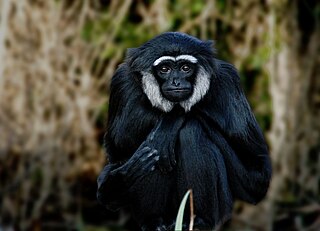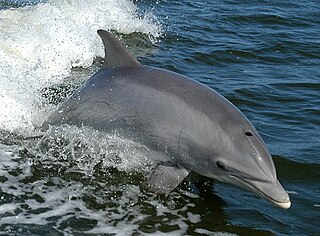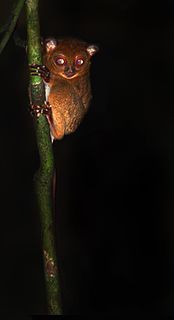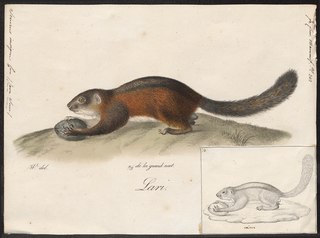 W
WThe African clawless otter, also known as the Cape clawless otter or groot otter, is the second-largest freshwater species of otter. African clawless otters are found near permanent bodies of water in savannah and lowland forest areas. They range through most of sub-Saharan Africa, except for the Congo River basin and arid areas. They are characterized by partly webbed and clawless feet, from which their name is derived. The word aonyx means "clawless", derived from the prefix a- ("without") and onyx ("claw/hoof").
 W
WThe agile gibbon, also known as the black-handed gibbon, is an Old World primate in the gibbon family. It is found in Indonesia on the island of Sumatra, Malaysia, and southern Thailand. The species is listed as endangered on the IUCN Red List due to habitat destruction and the pet trade.
 W
WThe Antillean ghost-faced bat is a species of bat in the family Mormoopidae. It is found in Cuba, the Dominican Republic, Haiti, Jamaica, and Puerto Rico.
 W
WThe Jamaican, common or Mexican fruit bat is a fruit-eating bat native to Mexico, through Central America to northwestern South America, as well as the Greater and many of the Lesser Antilles. It is also an uncommon resident of the Southern Bahamas. Populations east of the Andes in South America are now usually regarded a separate species, the flat-faced fruit-eating bat. The distinctive features of the Jamaican fruit bat include the absence of an external tail and a minimal, U-shaped interfemoral membrane.
 W
WThe Asiatic cheetah, also known as Iranian cheetah, is a Critically Endangered cheetah subspecies surviving today only in Iran. It once occurred from the Arabian Peninsula and the Near East to the Caspian region, Kyzylkum Desert and India, but has been extirpated there during the 20th century.
 W
WThe banded linsang is a linsang, a tree-dwelling carnivorous mammal native to the Sundaic region of Southeast Asia.
 W
WThe binturong, also known as bearcat, is a viverrid native to South and Southeast Asia. It is uncommon in much of its range, and has been assessed as Vulnerable on the IUCN Red List because of a declining population trend that is estimated at more than 30% since the mid 1980s.
 W
WThe black myotis, is a vesper bat species from South and Central America.
 W
WThe clouded leopard is a wild cat inhabiting dense forests from the foothills of the Himalayas through mainland Southeast Asia into southern China. The first clouded leopard known to science was brought to London from China in the early 19th century and described in 1821. It has large dusky-grey blotches and irregular spots and stripes forming a clouded pattern. Its head-and-body length ranges from 68.6 to 108 cm with a 61 to 91 cm long tail. It uses its tail for balancing when moving in trees and is able to climb down vertical tree trunks head first. It rests in trees during the day and hunts by night on the forest floor.
 W
WThe common bottlenose dolphin or Atlantic bottlenose dolphin is the most well-known species of the family Delphinidae.
 W
WThe crab-eating macaque, also known as the long-tailed macaque, is a cercopithecine primate native to Southeast Asia. It is referred to as the cynomolgus monkey in laboratories. It has a long history alongside humans; it has been alternately seen as an agricultural pest, sacred animal in some temples, and more recently, the subject of medical experiments.
 W
WThe cream-coloured giant squirrel or pale giant squirrel is a large tree squirrel in the genus Ratufa found in forests in the Thai-Malay Peninsula, Sumatra (Indonesia), Borneo and nearby small islands. There have been no sightings in Singapore since 1995 and it is believed to be extinct. Reported sightings in Vietnam in 1984 are considered to be dubious.
 W
WHorsfield's tarsier, also known as the western tarsier, is the only species of tarsier in the genus Cephalopachus. It occurs on Borneo, Sumatra and nearby islands and is, like other members of the group, entirely nocturnal.
 W
WThe Jamaican, common or Mexican fruit bat is a fruit-eating bat native to Mexico, through Central America to northwestern South America, as well as the Greater and many of the Lesser Antilles. It is also an uncommon resident of the Southern Bahamas. Populations east of the Andes in South America are now usually regarded a separate species, the flat-faced fruit-eating bat. The distinctive features of the Jamaican fruit bat include the absence of an external tail and a minimal, U-shaped interfemoral membrane.
 W
WThe large bamboo rat, Sumatran rat, or Indomalayan rat is a species of rodent in the family Spalacidae found in Cambodia, China, Indonesia, Laos, Malaysia, Myanmar, Thailand, and Vietnam. It is one of four species of bamboo rat. Individuals can reach lengths of nearly 50 cm (20 in) with a 20 cm (7.9 in) tail, and weigh up to 4 kilograms (8.8 lb).
 W
WThe large treeshrew is a treeshrew species within the Tupaiidae. It is native to Sumatra and adjacent small islands, as well as in the lowlands and hills of Borneo.
 W
WLeach's single leaf bat, also known as Greater Antillean long-tongued bat, is a species of bat in the family Phyllostomidae. It is found in southern Bahamas, Cuba, Jamaica, Hispaniola, and Puerto Rico. It forms large colonies, with up to a few hundred thousand individuals, and feeds on a relatively wide variety of food items including pollen, nectar, fruit and insects.
 W
WThe lesser Asiatic yellow bat is a species of vesper bat. It is found in Bangladesh, India, Indonesia, Malaysia, Pakistan, the Philippines, Sri Lanka, and Taiwan.
 W
WThe lesser mouse-deer, lesser Malay chevrotain, or kanchil is a species of even-toed ungulate in the family Tragulidae.
 W
WThe long-legged bat is a member of the Phyllostomidae family in the order Chiroptera. Both males and females of this species are generally small, with wingspans reaching 80mm with an average weight ranging between 6 and 9 grams. The facial structure of these bats includes a shortened rostrum with a prominent noseleaf. The most defining feature of these bats however, is their long posterior limbs that extend farther than most Phyllostomidae bats. At the ends of these hind legs, the long-legged bat has abnormally large feet equipped with strong claws.
 W
WThe margay is a small wild cat native to Central and South America. A solitary and nocturnal cat, it lives mainly in primary evergreen and deciduous forest.
 W
WThe Jamaican, common or Mexican fruit bat is a fruit-eating bat native to Mexico, through Central America to northwestern South America, as well as the Greater and many of the Lesser Antilles. It is also an uncommon resident of the Southern Bahamas. Populations east of the Andes in South America are now usually regarded a separate species, the flat-faced fruit-eating bat. The distinctive features of the Jamaican fruit bat include the absence of an external tail and a minimal, U-shaped interfemoral membrane.
 W
WNyctophilus geoffroyi is a vespertilionid bat, a flying nocturnal mammal found in Australia, The species is relatively common. They have been referred to as the lesser long-eared bat.
 W
WThe silky short-tailed bat is a bat species from South and Central America. It is found in Bolivia, Brazil, Colombia, Ecuador, French Guiana, Guyana, Panama, Peru, Suriname, Mexico and Venezuela.
 W
WThe silvery lutung, also known as the silvered leaf monkey or the silvery langur, is an Old World monkey. It is arboreal, living in coastal, mangrove, and riverine forests in Peninsular Malaysia, Sumatra, and Borneo.
 W
WThe Sumatran dhole, also known as the Sumatran wild dog is a subspecies of dhole native to the Indonesian islands of Sumatra.
 W
WThe black-crested Sumatran langur is a species of primate in the family Cercopithecidae. It is endemic to Sumatra in Indonesia. Its natural habitat is subtropical or tropical dry forests. It is threatened by habitat loss.
 W
WThe sun bear is a species in the family Ursidae occurring in the tropical forests of Southeast Asia. It is the smallest bear, standing nearly 70 centimetres at the shoulder and weighing 25–65 kilograms. It is stockily built, with large paws, strongly curved claws, small rounded ears and a short snout. The fur is generally jet-black, but can vary from grey to red. Sun bears get their name from the characteristic orange to cream coloured chest patch. Its unique morphology—inward-turned front feet, flattened chest, powerful forelimbs with large claws—suggests adaptations for climbing.
 W
WThe thirteen-lined ground squirrel, also known as the striped gopher, leopard ground squirrel, squinney,, is a ground squirrel that is widely distributed over grasslands and prairies of North America.
 W
WThe three-striped ground squirrel is a species of rodent in the family Sciuridae. It is found in Indonesia, Malaysia, and Thailand.
 W
WThe tree pangolin is one of eight extant species of pangolins, and is native to equatorial Africa. Also known as the white-bellied pangolin or three-cusped pangolin, it is the most common of the African forest pangolins.
 W
WThe vervet monkey, or simply vervet, is an Old World monkey of the family Cercopithecidae native to Africa. The term "vervet" is also used to refer to all the members of the genus Chlorocebus. The five distinct subspecies can be found mostly throughout Southern Africa, as well as some of the eastern countries. Vervets were introduced to Florida, St. Kitts and Nevis, and Cape Verde. These mostly herbivorous monkeys have black faces and grey body hair color, ranging in body length from about 40 cm (16 in) for females, to about 50 cm (20 in) for males.
 W
WThe western mastiff bat, also known as the western bonneted bat, the greater mastiff bat, or the greater bonneted bat, is a member of the free-tailed bat family, Molossidae. It is found in the Western United States, Mexico and South America, and is the largest bat native to North America. The subspecies Eumops perotis californicus is a species of concern as identified by the U.S. Fish and Wildlife Service. The range of this subspecies is principally southwest desert regions of the United States, along the border with Mexico; however, the range extends as far north on the Pacific coast to Alameda County, California.